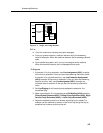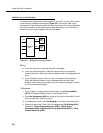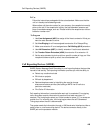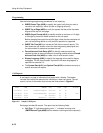
Call Reporting Devices (SMDR)
4-9
To Use
Follow the instructions packaged with the auto attendant. Make sure that the
unit is in backup call-answering mode.
When callers call the main number for your company, the receptionist normally
picks up the call. If the receptionist is busy, the auto attendant answers and
plays a recorded message, such as: “Please hold for the receptionist or dial an
extension number now.”
To Program
1. Use Line Assignment (#301) to assign all the lines to extension X that you
want the auto attendant to cover.
2. Set Line Ringing for all lines assigned to extension X to Delayed Ring.
3. Make sure extension X is not assigned as a Call Waiting (#316) extension.
4. Use AA Extensions (#607) to identify extension X as the auto attendant.
5. Set Transfer Return Extension (#306) for extension X to extension 10.
6. Set the auto attendant to pick up within a specific number of rings, so if the
receptionist does not pick up a call, the auto attendant will.
Call Reporting Devices (SMDR)
SMDR (Station Message Detail Recording) is a
call reporting
feature that provides
records of call activity. Call reporting information provides you with the ability to:
■ Detect any unauthorized calls
■ Bill clients or projects
■ Bill back by department
■ Reduce telephone costs by identifying the need to change
telecommunications services (like adding a WATS line for calls to a
particular area code)
■ Print Caller ID information
Call reporting information is recorded after each call is completed. For outgoing
calls, the system records information for each call that lasts more than 10
seconds. The timing begins when you lift the handset or press
S to access an
outside line. For incoming calls, the timing begins when the call is answered.
Timing stops when the call is disconnected.
The system sends the information through a 1200-baud serial interface to either a
serial printer or a call accounting device. The device connects directly to the
SMDR jack on the processor module.


















